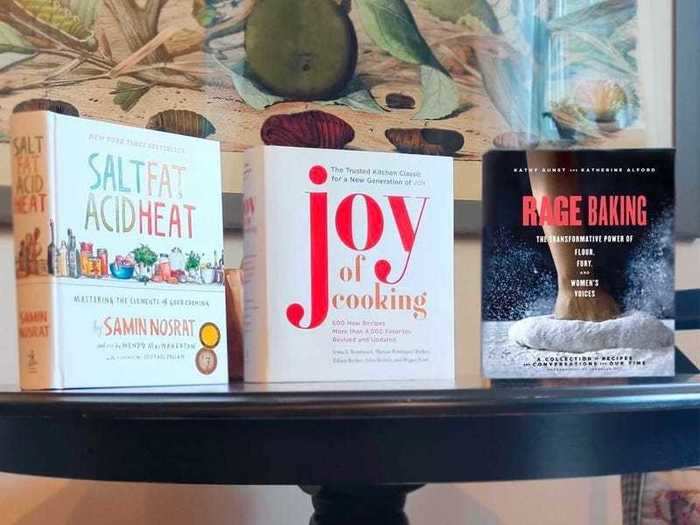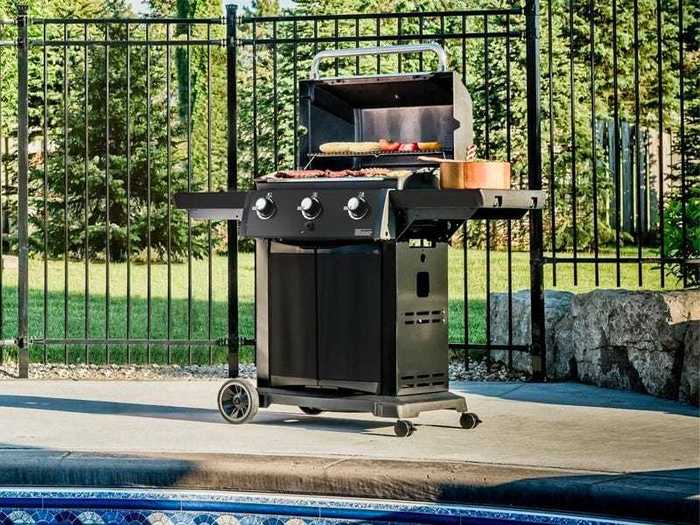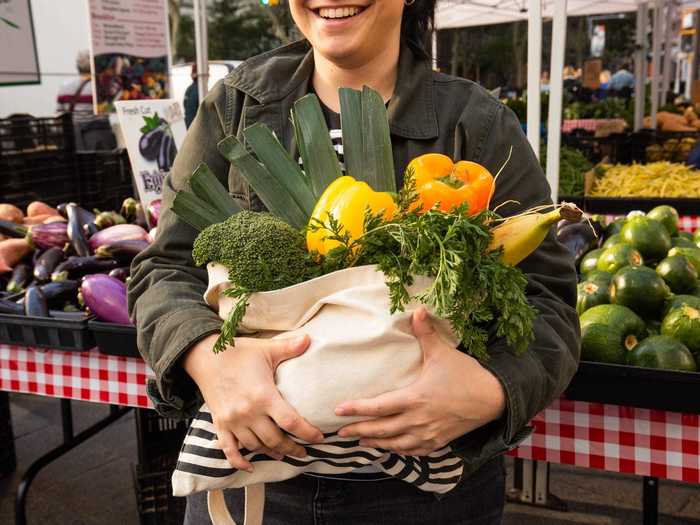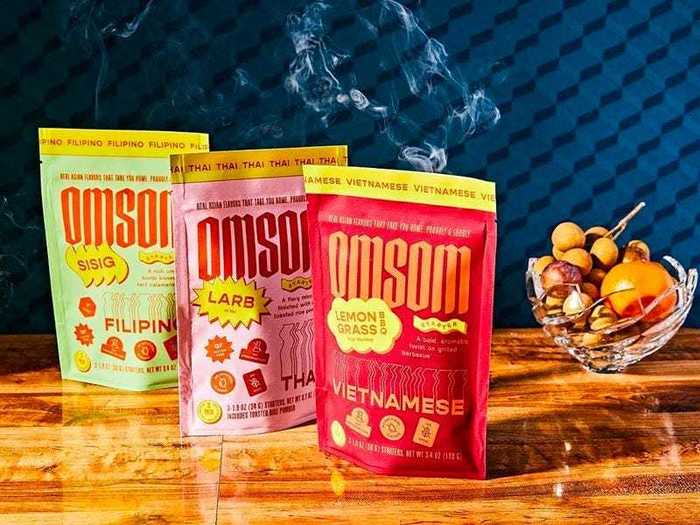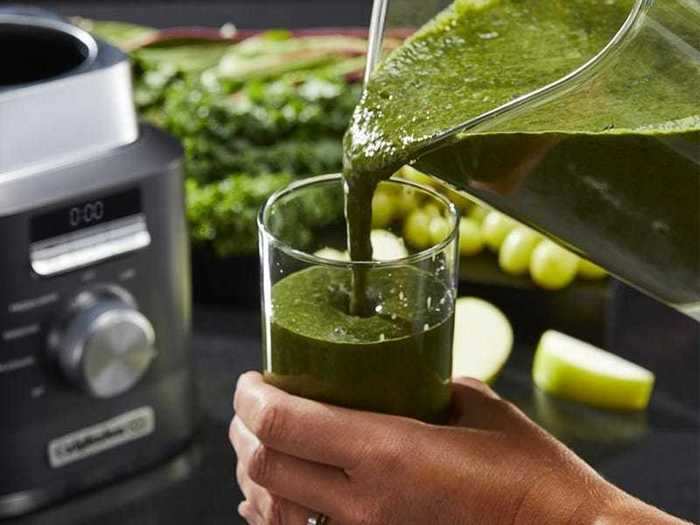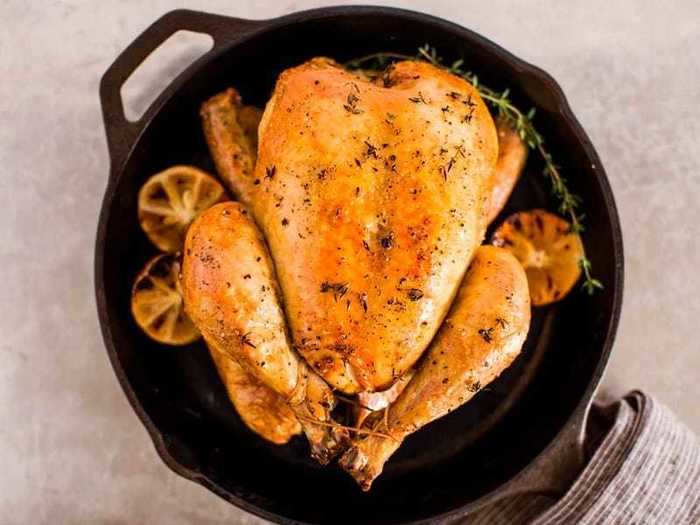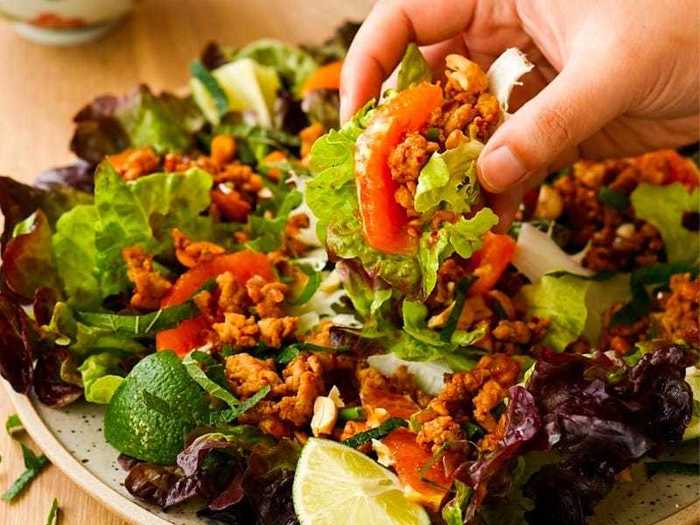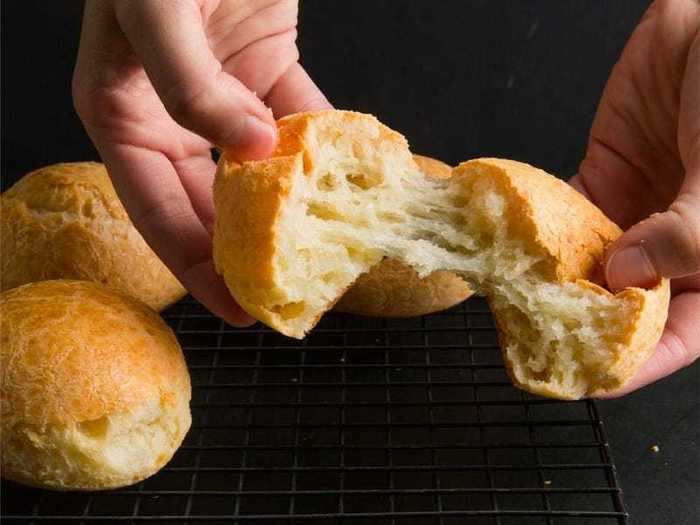iStock; Alyssa Powell/Business Insider
When you buy through our links, we may earn money from our affiliate partners. Learn more.
- As the pandemic continues, it's become harder to maintain the same enthusiasm for cooking as we had back in March and April.
- To help you get back into the kitchen, I asked professional chefs, food and drink brand founders, and cookbook authors how they continue to feel inspired.
- Among many other useful tips, they recommend visiting farmers markets, trying out new and unfamiliar ingredients, consulting diverse sources of inspiration, and using small kitchen appliances to speed up the process.
The pandemic has forced us to spend more time in the kitchen than ever. And though many of us initially embraced the cooking streak with gusto, the overall sentiment lately leans more towards fatigue and frustration.
I asked the experts — professional chefs, food and drink brand founders, and cookbook authors — how they overcome a cooking rut.
They provided excellent tips on where to find inspiration, how to deal with a hot kitchen if the summer weather is slowing you down, how to make the most of your leftovers, and more.
I couldn't include all of the responses, but here were the most common words of wisdom I received:
- Go to the farmers market or wander your local market. Let fresh produce and vibrant colors inspire you.
- Roasting a whole chicken is the best way to get the foundation for an entire week's worth of meals.
If you want to order less takeout, get back into the kitchen, and revive your love of cooking, try out these expert tips below.
First, embrace the rut.
Crystal Cox/Business Insider
Personally, I recommend letting yourself hit the rock bottom of a cooking rut. When I get in these moods, I let myself order all the takeout and make all the frozen foods, until I just cannot take not cooking anymore. —Seung Hee Lee, pop-up chef and author of Everyday Korean
The most extreme way to get myself out of a cooking rut is to first make the situation I'm in so unbearable that I'm desperate to get out of it. It's easy to just coast along when it's boring but not terrible. Meal planning is something I hate, like emptying a dishwasher. But I find four or five days of eating the same thing again and again makes me crave, so deeply into my f------ soul for flavor, different textures, exciting combinations, a challenge. —Michael Zee, creator of @symmetrybreakfast and author of SymmetryBreakfast
The first three months of the pandemic I cooked every meal every day. By the end of May, I was burnt out. I was cooking our meals, plus for my clients and my blog. It was a lot. Finally, I had to take a break and really just let someone else cook and so we ordered our first takeout meal. Let me tell you, it was glorious. Eating someone else's cooking was a breath of fresh air. After that meal, I had to get out of my head and just look for inspiration. Honestly, from someone that is always in the kitchen, the best way to get out of a cooking rut is to not cook. —Rezel Kealoha, recipe developer
Consult a trusty cookbook. Or pick up a new one.
Simon & Schuster/Instagram
For easy weeknight meals that are guaranteed crowd-pleasers, I just love Mark Bittman's website and cookbooks. They're remarkably user-friendly and often make enough for leftovers. My favorite is "How to Cook Everything Fast." —Paul C. Reilly, chef and owner at beast + bottle
I've always loved reading cookbooks cover-to-cover with Post-It notes ready to go for anything that inspires me. There are two kinds of cookbooks I love the most: first, ones that empower you with foundational knowledge and skills that you can use to level-up all of your cooking and second, ones that give rich cultural or historical context to the cuisines beyond recipes.
Some of my most-used cookbooks in the first group are "Salt, Fat, Acid, Heat" (Samin Nosrat); "The Food Lab" (J. Kenji López-Alt); and "The King Arthur Flour Baker's Companion," and in the second are "I Am a Filipino" (Nicole Ponseca) and "Night + Market" (Kris Yenbamroong). —Vanessa Pham, cofounder of Omsom
Get outside.
Broil King/Instagram
I love cooking completely in a location that is not the kitchen or your backyard grill. Plan a little cooking fun on your canoe in a lake, or at the top of your hike up among the wildflowers. Bring one good knife, a light small cutting board, great EVOO in a tiny travel bottle, and some salt and whatever ingredients are in season. Just the change in routine and scenery will already inspire you to think differently. —Linda Hampsten Fox, chef and owner of The Bindery Denver
When it is too hot to cook dinner, I try to grill outside as much as possible. We've been eating a lot of quickly grilled shrimp in corn tortillas with avocados smashed with lemon juice and salt and it is my fave savory recipe of the summer. —Jessie Sheehan, baker and author of The Vintage Baker
Wander the farmers market or a local grocery store you've never been to before.
Crystal Cox/Business Insider
Removing the boundaries around what you cook can be helpful and inspiring! On a weekday afternoon, go to a new market or grocery store, with no agenda or shopping list, and wander. Just see if you can build a dish or meal out of an ingredient that speaks to you, like a gorgeously ripe heirloom tomato, smoked duck breast, or chili oil. —Kim Pham, cofounder of Omsom
I always find inspiration by visiting my local farmers market and getting inspired by what is in season. Talking with the farmers and finding what they're excited about is a surefire way to build excitement in yourself and kick-start some culinary ideas. —Paul C. Reilly, chef and owner at beast + bottle
Try new spices and techniques.
Omsom/Instagram
A game-changer to get myself cooking more has been finding a few spices that I love that I know will make anything I cook taste good. My faves right now are the onion salt from Trader Joe's, Asian-inspired spice kits from Omsom, and a couple Tunisian spice mixes my mom sent me during quarantine. Throwing these on top of whatever I'm making, whether it's a quick stir fry or a salad, gets me so much more excited to eat it knowing it's going to be that much more flavorful. —Mayssa Chehata, founder and CEO of Behave
Macerating fruits and veggies is my favorite trick at this time of year. Take great fruits and veggies — especially the juicy ones like tomatoes, berries, stone fruits, cucumbers — and throw them in a bowl with salt or sugar and let them sit. They will turn into something more interesting. Macerating is great for sweet or savory preparations. Add herbs, too, to create a new summer salad: the flavors meld deliciously (this is the same concept as salsa or gazpacho, for example). —Charlie Brooks, executive chef at Sunday Vinyl
Use a small gadget or appliance to speed up the process.
Calphalon/Instagram
I love my mini food processor. I can blitz garlic, make pesto, and whip up sauces much, much faster. Then you just toss it in the dishwasher and you're good to go! —Kim Pham, cofounder of Omsom
Summertime is the perfect opportunity to keep the oven off and use small pieces of cooking equipment. My blender is whizzing all day. For breakfast, I make nutritious smoothies to start my day off and at night I make a ton of "nice cream" (made without dairy) as a guilt-free treat. I'm also a big fan of using my air fryer to make roast chicken, quesadillas, vegetables, crispy tofu, and more. —Catherine McCord, cofounder of One Potato, founder of Weelicious, and author of Smoothie Project
It's not super chef-y, but the Instant Pot is so convenient and a huge time-saver. You can cook big pieces of meat (like a pork shoulder for tacos, nachos, etc.) quickly or even cook from frozen. It's great for wintertime cooking but I'll also use it for rice and beans so that when I get home late I can make versatile and delicious dishes. I'll utilize beans, chickpeas, or rice as bases for grilled chicken with steamed rice and veggies and then the next day, I'll add an egg and use the same ingredients to make fried rice. —Cody Cheetham, chef de cuisine at Tavernetta Denver
Make the most of your leftovers.
Porter Road
My go-to hack for creating second meals, or having enough leftovers to turn it into something else, is to pull your "leftovers" aside before you plate up your first meal. That way you won't eat so much you're left with a tiny useless portion, plus it's an effective method of portion control if some is already reserved for another day. —Michael Zee, creator of @symmetrybreakfast and author of SymmetryBreakfast
I dislike leftovers so I try to create a new meal with my leftover ingredients. Replacing the microwave with a skillet will go a long way in making them more fun and flavorful. Few meals will not taste good reheated in a skillet with a fried egg on top. Or dipped cold in aioli. Or on top of white beans cooked in olive oil.
For instance, I always roast a whole chicken for dinner, and make chicken salad with the leftovers, and broth with the bones and my leftover vegetables. Later, I just add some noodles to them for chicken soup. —Melanie Masarin, founder and CEO of Ghia
My all time favorite for this hack is to roast a whole chicken, which honestly, could not be easier. A 3-3.5-pound chicken will roast at 450°F for 75 minutes. Stuff the cavity with lemons and garlic heads and boom, you're done. The first night you have roast chicken. Any leftover meat can be picked and mixed with celery, pickles, and yogurt for chicken salad sandwiches the next day. Save the bones and you have chicken noodle soup for dinner or lunch another day. It's about a $15 investment for three meals.—Paul C. Reilly, chef and owner at beast + bottle
I always think of a few things when meal planning: how can I incorporate this into either a stew, fried rice, frittata or a baked shepherd's pie of sorts. If you are reheating, I like to throw everything in the oven at 300°F with a little bit of stock or water to help keep the pre-cooked food hydrated so it does not dry out. If you can incorporate water or liquid into reheating, you will always get a better end result. —Joshua Sutcliff, executive chef at Local Jones
If the summer heat is getting to you, stick to cold platters and dishes.
SideChef/Instagram
I live in Atlanta, GA and my kitchen doesn't have any ventilation — it gets hot! Whenever the temperatures go up I tend to do a lot of cold cooking: crudos and noodle dishes in particular. One of the recipes I return to often is my DIY Bibimguksu (mixed cold noodles).
Yes, you do have to boil the noodles for this dish, but you end up rinsing them under cold water before serving, and all of the toppings are super easy and interchangeable. If you have leftover pulled pork, pop it on! Cold cucumbers, carrots, raw tomatoes, it all works.
If you have a mandoline it's easy to make it look beautiful, but not necessary for it to be delicious. The noodle holds up really well, too. I like to make two portions and save one for the next day's lunch. —Seung Hee Lee, pop-up chef and author of Everyday Korean
My kitchen at home is full of beautiful, large western-facing windows, which means it is hot and sunny during summer dinnertime. Crank up the oven and a few stove burners, and it heats up fast.
At my house, we have come to appreciate the beauty of cutting board grazing! I will go beyond the normal expectations of a cheese and charcuterie display. The board is really a representation of what we have lingering in the fridge. Fresh fruits, veggies and dip, a sandwich cut in bite-sized pieces, toasted nuts, last night's roasted potatoes, maybe a hunk of crusty bread…The list is endless, but the name of the game is cold food without the pressure of tons of dishes, and letting the family graze on their own time. —Bonnie Moore, executive chef at Three Sisters, Blackberry Mountain
Expand your follow lists.
America's Test Kitchen/Instagram
I love to watch great chefs cook and YouTube and social media have made it easier than ever to do so. I follow some of my favorite chefs such as Bobby Flay, Alex Guarnaschelli, Andrew Zimmern, Marcus Samuelsson, Jeff Mauro, and Anthony Vitolo to see what they're cooking and how they're doing it, and also search YouTube for videos to inspire new ideas and teach me along the way, including videos of Pro Home Cooks and Not Another Cooking Show. —Daniel Kamhi, cofounder and CEO of Sardel
The bloggers that I follow are on Instagram (Smitten Kitchen) posting about their new recipes, as are the websites I like (King Arthur Baking, America's Test Kitchen), the bakers (Caroline Schiff, Zoe Kanan, Erin McDowell), and the food editors (Eric Kim, Grace Elkus, Emma Laperruque).—Jessie Sheehan, baker and author of The Vintage Baker
I'm always out of time but rarely out of ideas! I follow a lot of chefs on Instagram — my favorites during quarantine are Taku Sekine, Frederik Bille Brahe, Helene Darroze, and Joseph Viola (from my hometown). They all have very different cooking styles and different regional inspirations, and they are generous with their techniques. My foodie friends Mia Moretti, Anna Polonsky, and Emilien Crespo and I share a lot of our recipes and techniques as well. —Melanie Masarin, founder and CEO of Ghia
Lately, I've been loving looking to 101Cookbooks (Heidi Swanson) and Milk and Cardamom (Hetal Vasavada) for inspiration. I also love Brightland's own Field Notes where we feature recipes from chefs, recipe developers and some of our favorite entrepreneurs and tastemakers. —Aishwarya Iyer, founder and CEO of Brightland


